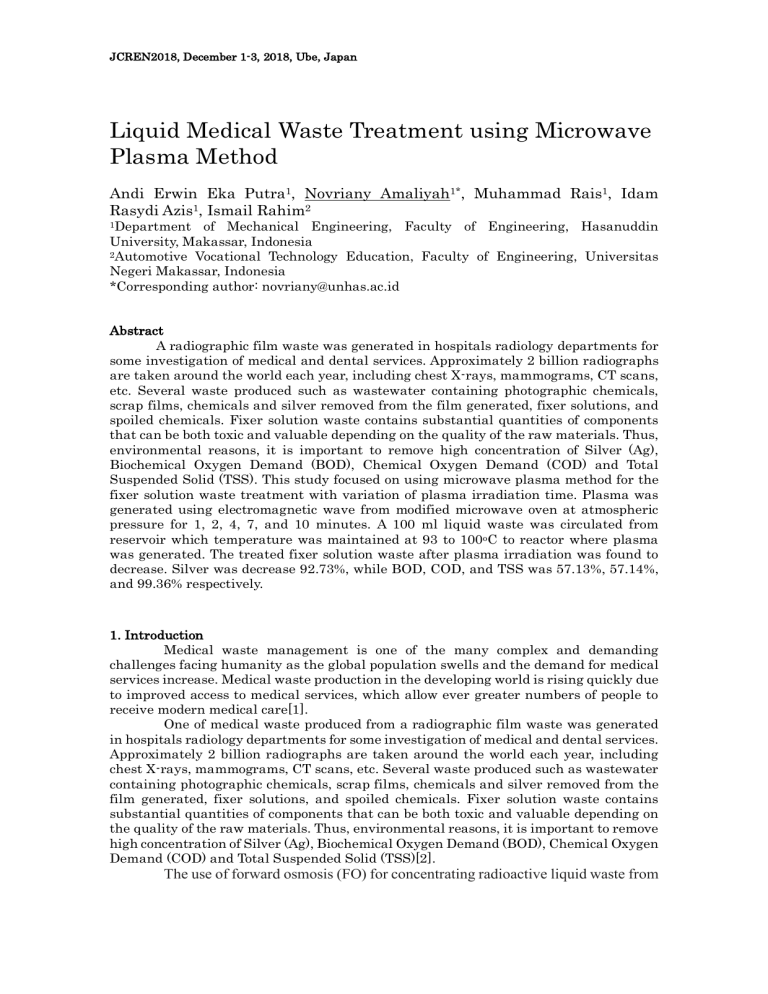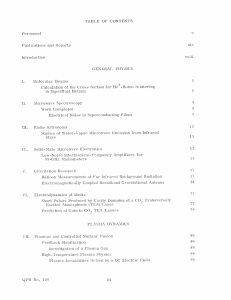
JCREN2018, December 1-3, 2018, Ube, Japan Liquid Medical Waste Treatment using Microwave Plasma Method Andi Erwin Eka Putra1, Novriany Amaliyah1*, Muhammad Rais1, Idam Rasydi Azis1, Ismail Rahim2 1Department of Mechanical Engineering, Faculty of Engineering, Hasanuddin University, Makassar, Indonesia 2Automotive Vocational Technology Education, Faculty of Engineering, Universitas Negeri Makassar, Indonesia *Corresponding author: novriany@unhas.ac.id Abstract A radiographic film waste was generated in hospitals radiology departments for some investigation of medical and dental services. Approximately 2 billion radiographs are taken around the world each year, including chest X-rays, mammograms, CT scans, etc. Several waste produced such as wastewater containing photographic chemicals, scrap films, chemicals and silver removed from the film generated, fixer solutions, and spoiled chemicals. Fixer solution waste contains substantial quantities of components that can be both toxic and valuable depending on the quality of the raw materials. Thus, environmental reasons, it is important to remove high concentration of Silver (Ag), Biochemical Oxygen Demand (BOD), Chemical Oxygen Demand (COD) and Total Suspended Solid (TSS). This study focused on using microwave plasma method for the fixer solution waste treatment with variation of plasma irradiation time. Plasma was generated using electromagnetic wave from modified microwave oven at atmospheric pressure for 1, 2, 4, 7, and 10 minutes. A 100 ml liquid waste was circulated from reservoir which temperature was maintained at 93 to 100oC to reactor where plasma was generated. The treated fixer solution waste after plasma irradiation was found to decrease. Silver was decrease 92.73%, while BOD, COD, and TSS was 57.13%, 57.14%, and 99.36% respectively. 1. Introduction Medical waste management is one of the many complex and demanding challenges facing humanity as the global population swells and the demand for medical services increase. Medical waste production in the developing world is rising quickly due to improved access to medical services, which allow ever greater numbers of people to receive modern medical care[1]. One of medical waste produced from a radiographic film waste was generated in hospitals radiology departments for some investigation of medical and dental services. Approximately 2 billion radiographs are taken around the world each year, including chest X-rays, mammograms, CT scans, etc. Several waste produced such as wastewater containing photographic chemicals, scrap films, chemicals and silver removed from the film generated, fixer solutions, and spoiled chemicals. Fixer solution waste contains substantial quantities of components that can be both toxic and valuable depending on the quality of the raw materials. Thus, environmental reasons, it is important to remove high concentration of Silver (Ag), Biochemical Oxygen Demand (BOD), Chemical Oxygen Demand (COD) and Total Suspended Solid (TSS)[2]. The use of forward osmosis (FO) for concentrating radioactive liquid waste from JCREN2018, December 1-3, 2018, Ube, Japan radiation therapy rooms in hospitals was systematically investigated. The removal of natural and radioactive iodine using FO was first investigated with varying pHs and draw solutions (DSs) to identify the optimal conditions for FO concentration. Results showed that FO had a successful rejection rate for both natural and radioactive iodine of up to 99.3% [3]. In a previous study Electrolysis was used to recover silver from the waste fixer solutions, where the cathode plate and the anode plate were made of stainless steel and graphite, respectively. For an electric current of 0.9 A, the silver recovery was 83.88%, which was better than the silver recovery for any of the other electric currents that were studied (0.1 A, 0.3 A, 0.5 A, and 0.7 A)[2][4] Several research groups worldwide apply microwave plasma processes for the synthesis of particulate matter, mainly. The advantage of using microwave energy is, that higher degrees of ionization and dissociation can be obtained, compared to other types of electrical excitation [16]. This higher ionization and dissociation reduces the activation energy and enhances the kinetics to initiate a chemical reaction. Furthermore, lower temperatures can be realized in comparison to thermal plasmas or standard thermal reactions, being favorable for yielding in smaller particles[5] 2. Experimental The experimental apparatus is shown in figure 1. Plasma generated using a conventional microwave oven with dimension 470 mm width, 330 mm depth and 310 mm height. Microwave was modified by cut the heating area and replaced with a waveguide. Microwave output was 85/500 Watt and 2450 MHz. A reactor and reservoir were made from acrylic and Teflon was used to gather liquid waste. Fig.1 Experimental Apparatus JCREN2018, December 1-3, 2018, Ube, Japan A 100 ml liquid waste was circulated from reservoir which temperature was maintained at 93 to 100oC to reactor where plasma was generated at 500 W microwave oven power and pressure 1 atm. Plasma generation time was varied for 1, 2, 4, 7, and 10 minutes. The treated liquid then analyzed using UV-2900 PC Spectrophotometer for Total Suspended Solid (TSS) analysis, AA 700 SHIMADZU for Silver analysis, and titration method for Biological Oxygen Demand (BOD) and Chemical Oxygen Demand (COD) analysis. 3. Results and Discussion Table 1 shows analysis parameter of liquid waste before and after plasma treatment. Silver was decrease 92.73%, while BOD, COD, and TSS was 57.13%, 57.14%, and 99.36% respectively. Table 1. Analysis Parameter of Liquid Waste No Analysis Parameter Unit Analysis after plasma treatment Analysis before plasma treatment 1 2 4 7 10 328.0 1.37 1.54 0.92 1,24 2,09 100 4.67 4.86 4.86 4.85 4,86 4,83 6–9 Time (minutes) Standard PHYSICS 1 TSS ppm CHEMICAL 2 Ph 3 Silver (Ag) ppm 0.2354 0.062 0.0155 0.0064 0,0195 0,0171 0.05 4 BOD ppm 13336.0 11143.0 9287 7144 6329,2 5716,2 50 5 COD ppm 33337.0 28572.8 23215 17858 15745 14286,4 100 After plasma treatment, liquid waste color was changed from clear liquid become darker observed by naked eye. At the bottom was found black powder that assumed to be silver recovered by the plasma treatment. Plasma irradiation time give a significant effect on COD, BOD, and Silver content. The longer plasma irradiation time, a high concentration of BOD, COD and Silver was decreased. JCREN2018, December 1-3, 2018, Ube, Japan 4. Conclusion Modification of 2.45 GHz microwave oven can generate plasma in liquid medical waste at a pressure of 1 atm by maintaining the temperature of the liquid in the reactor at 93oC - 100oC in a circulation state. Plasma appears stable for up to 600 seconds with yellow plasma color. Application of plasma technology in liquid waste treatment shows a decrease in TSS levels of 99.36%, Silver (Ag) of 92.73%, pH of 3.42%, BOD (Biochemical Oxygen Demand) of 57.13%, and COD (Chemical Oxygen Demand) is 57.14%. References [1] E. S. Windfeld and M. S. L. Brooks, “Medical waste management - A review,” J. Environ. Manage., vol. 163, pp. 98–108, 2015. [2] W. T. Chen, C. C. Ma, M. H. Lee, Y. C. Chu, L. C. Tsai, and C. M. Shu, “Silver recovery and chemical oxygen demand (COD) removal from waste fixer solutions,” Appl. Energy, vol. 100, pp. 187–192, 2012. [3] S. Lee, Y. Kim, J. Park, H. K. Shon, and S. Hong, Treatment of medical radioactive liquid waste using Forward Osmosis (FO) membrane process, vol. 556. Elsevier B.V., 2018. [4] P. Klangsin and A. K. Harding, “Medical Waste Treatment and Disposal Methods Used by Hospitals in Oregon, Washington, and Idaho,” J. Air Waste Manage. Assoc., vol. 48, no. 6, pp. 516–526, 1998. [5] D. Szabó and S. Schlabach, “Microwave Plasma Synthesis of Materials—From Physics and Chemistry to Nanoparticles: A Materials Scientist’s Viewpoint,” Inorganics, vol. 2, no. 3, pp. 468–507, Aug. 2014.


